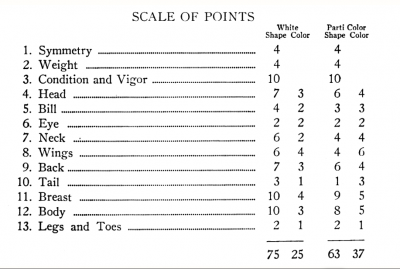Pomeranian
| Pomeranian | |||
|---|---|---|---|
| Origin | Category | Egg Colour | Sitter |
| Germany | Goose | White | Yes |
This breed is a popular German goose, where it has been bred in large numbers. It takes its name from the province of Pommerania in the North East section of that country. It is of imtermediate size and robust construction.
In certain respects, it differs from most European breeds, being characterized by a pink, or reddish orange, colored bill, with corresponding feet and shanks, and also, by a single lobed paunch, or abdomen, instead of the more widely preferred dual lobed, square based paunch, specified for such breeds as the Embden and the Toulouse.
In some countries the Pomeranian is recognised in a variety of colours, the pure Whites, the Grays, as in the Toulouse, and the Pied, or Saddlebacks (Gray-backs) and the Buff version of the saddleback. In Australia just two colours are recognised - the Grey (Saddleback) and the Buff.
These geese are reputed to be prolific layers, while the goslings make very rapid growth and both young and adults are sturdy and possess very docile dispositions
GENERAL CHARACTERISTICS
SHAPE OF MALE AND FEMALE
HEAD: Fairly broad, strong and medium length.
BILL: Moderately long, stout, but with slightly concave culmen.
EYES: Large and alert.
NECK: Nearly straight, upright, sturdy, of medium length; devoid of dewlap.
BACK: Slightly convex from shoulders to tail, rather broad in relation to length, but not noticeably short when viewed in profile.
TAIL: Slightly more than average length, moderately spread and in line with back.
WINGS: Well developed, carried close to body and with tips crossing over rump.
BODY: Proportionate to back in length and breadth, but massive and heavily fleshed.
BREAST: Very broad and deep, blending smoothly into chest; with out keel.
PAUNCH: Wide, capacious, but with a single lobed appendage, tapering toward the base, clear of the ground.
LEGS: Thighs; medium length, mostly obscured by the large thigh coverts. Shanks; conservative length, stout, but not heavy boned.
PLUMAGE: Smooth, bright, but not overly profuse.
CARRIAGE: Nearly horizontal and docile.
COLOUR
COLOR OF SADDLE-BACK OR PIED MALE AND FEMALE
HEAD AND UPPER PORTION OF NECK: Dark gray. Lower part of neck pure white.
BILL: Pink, or orange red, with light flesh colored bean.
EYES: Brown.
BACK: Scapulars; dark gray, edged with light gray, approaching white. Upper section of the back, same as scapulars. Rump; bluish gray.
TAIL: Mostly white, with a broad band of gray across the base.
WINGS: Primaries, secondaries, tertials and lower coverts, white; thus, when folded, forming the border of a gray, almost heart shaped design over the shoulders and upper back.
REMAINDER OF PLUMAGE: Pure white, except for the large thigh coverts, which are dark gray, edged with almost pure white, all color sections sharply defined.
COLOR OF GRAY MALE AND FEMALE
PLUMAGE: Identical with that of the Toulouse in color, with brown eyes.
COLOR OF WHITE MALE AND FEMALE
PLUMAGE: Pure white in all sections, with blue eyes.
COLOUR OF MALE AND FEMALE IN BUFF
PLUMAGE: Identical with the Saddleback with the Grey colour replaced by Buff.
COLOR OF MALE AND FEMALE IN ALL VARIETIES
BILLS: Pink, to orange red; bean light flesh, or whitish horn color.
FEET AND SHANKS: Pinkish to reddish orange.
WEIGHTS
Adult male, about 17 lbs. Adult female, about 15 lbs. Young male, about 15 lbs. Young female, about 13 lbs.
SCALE OF POINTS
SERIOUS DEFECTS
Orange colored bills, feet and shanks. Dewlaps. Double lobed paunch. Keels on breast or chest.
SOURCES
- Grow, O. (1956). Universal waterfowl standard and judging guide. Milwaukee: American Waterfowl Assoc., inc. https://babel.hathitrust.org/cgi/pt?id=coo.31924003128190&view=1up&seq=9
- Australian Poultry Standards 2nd edition



